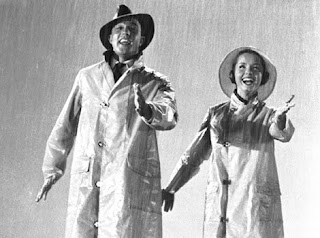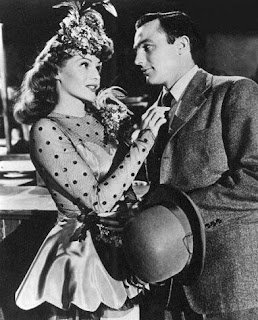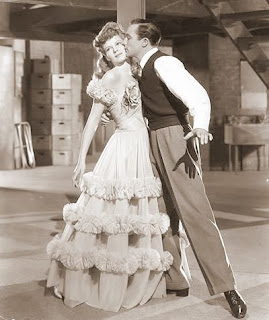 "As Gershwin transitions from car horns to a wailing trumpet to gliding strings, Gene Kelly and Leslie Caron play cat and mouse among sets inspired by painters inspired by Paris, including Dufy, Renoir, Utrillo, Rousseau, Van Gogh, and Toulouse-Lautrec. Perhaps 'An American in Paris' was the upset Best Picture Oscar winner because of the ballet. With its merging of high and middlebrow art, it was cinematically progressive in ways that front-runners 'A Place in the Sun' and 'A Streetcar Named Desire' weren't. Academy voters may have seen in 'An American in Paris' the future of movies". Source: www.brightlightsfilm.com
"As Gershwin transitions from car horns to a wailing trumpet to gliding strings, Gene Kelly and Leslie Caron play cat and mouse among sets inspired by painters inspired by Paris, including Dufy, Renoir, Utrillo, Rousseau, Van Gogh, and Toulouse-Lautrec. Perhaps 'An American in Paris' was the upset Best Picture Oscar winner because of the ballet. With its merging of high and middlebrow art, it was cinematically progressive in ways that front-runners 'A Place in the Sun' and 'A Streetcar Named Desire' weren't. Academy voters may have seen in 'An American in Paris' the future of movies". Source: www.brightlightsfilm.com "An American In Paris" (1951) won 6 Oscars and Gene Kelly was given a Honorary Award in appreciation of his versatility as an actor, singer, director and dancer, and choreography on film.
"An American In Paris" (1951) won 6 Oscars and Gene Kelly was given a Honorary Award in appreciation of his versatility as an actor, singer, director and dancer, and choreography on film. Gene Kelly’s final filmed words are from 1994’s 'That’s Entertainment III' quoting Irving Berlin, he remarked: “The song has ended, but the melody lingers on.” And, so too has Kelly himself. He was number 15 on AFI’s millennium list of most popular actors and 'Singin’ in the Rain' has been voted the singular most popular movie musical of all time.
Gene Kelly’s final filmed words are from 1994’s 'That’s Entertainment III' quoting Irving Berlin, he remarked: “The song has ended, but the melody lingers on.” And, so too has Kelly himself. He was number 15 on AFI’s millennium list of most popular actors and 'Singin’ in the Rain' has been voted the singular most popular movie musical of all time. Gene Kelly with his daughter Kerry and wife Betsy Blair
Gene Kelly with his daughter Kerry and wife Betsy Blair"He once said he hoped most that he had made people happy", said daughter Kerry Kelly Novick the day his father died.
 Speaking of 'Singin in the Rain', he told People magazine, "The picture was done with joy, and it brings joy. That's what I always tried to do".
Speaking of 'Singin in the Rain', he told People magazine, "The picture was done with joy, and it brings joy. That's what I always tried to do". Gene Kelly was nominated to an Oscar for Best Actor in a Leading Role for "Anchors Aweigh" (1945)
Gene Kelly was nominated to an Oscar for Best Actor in a Leading Role for "Anchors Aweigh" (1945)“There is a strange sort of reasoning in Hollywood that musicals are less worthy of Academy consideration than dramas. It's a form of snobbism, the same sort that perpetuates the idea that drama is more deserving of Awards than comedy.” -Gene Kelly
 “If Gene was endowed with total talent, so too, was he endowed with total integrity. His fierce urge for perfection, his almost fanatical need for success, have always been matched by his need for justice for the less gifted, or less advantaged, whose paths crossed his. Gene climbed to the top but he didn’t step on any hearts on his way up. If they ever get around to handing out Oscars for outstanding performance as a human being, you’ll know where to find Ol’Blue Eyes - on the nominating committee rooting for his old buddy, Gene.” -Frank Sinatra about Gene Kelly: a foreword to ‘Gene Kelly Biography’ by Clive Hirschhorn
“If Gene was endowed with total talent, so too, was he endowed with total integrity. His fierce urge for perfection, his almost fanatical need for success, have always been matched by his need for justice for the less gifted, or less advantaged, whose paths crossed his. Gene climbed to the top but he didn’t step on any hearts on his way up. If they ever get around to handing out Oscars for outstanding performance as a human being, you’ll know where to find Ol’Blue Eyes - on the nominating committee rooting for his old buddy, Gene.” -Frank Sinatra about Gene Kelly: a foreword to ‘Gene Kelly Biography’ by Clive Hirschhorn "Gene Kelly's characters had similar traits, such as being an entertainer or a serviceman; craving control; being the All-American male, and so on. No matter which genre Kelly worked in, he would find a way of making a quintessentially Kelly film, usually by using his own body on screen, whether he was directing the film or not.
"Gene Kelly's characters had similar traits, such as being an entertainer or a serviceman; craving control; being the All-American male, and so on. No matter which genre Kelly worked in, he would find a way of making a quintessentially Kelly film, usually by using his own body on screen, whether he was directing the film or not. These two opposing themes of ‘sameness’ and ‘difference and singularity’ are also apparent in the Kelly persona as he tried to present his authenticity by portraying the Everyman, the ‘blue-collar guy’ on the street.
These two opposing themes of ‘sameness’ and ‘difference and singularity’ are also apparent in the Kelly persona as he tried to present his authenticity by portraying the Everyman, the ‘blue-collar guy’ on the street. Parallels can also be drawn between Kelly’s repressed talents at MGM and those of his character Don Lockwood in 'Singin’ in the Rain'.
Parallels can also be drawn between Kelly’s repressed talents at MGM and those of his character Don Lockwood in 'Singin’ in the Rain'. Gene Kelly occupies both the pro-filmic and filmic space with his movements. He quite literally takes control of the filmic space in 'Singin’ in the Rain' by setting the scene for the musical number ‘You Were Meant for Me’ on an empty sound stage, thus becoming director, technician and performer. This number displays a sense of complete control since it combines both directorial and romantic control. Don is showing us that he not only knows about working in front of the camera (since he is an actor) but also what is involved, in even the slightest technical job, behind the camera. With Kelly portraying an actor with technical knowledge he is not only acting a part on-screen but manifesting his own knowledge in this character, from both sides of the camera.
Gene Kelly occupies both the pro-filmic and filmic space with his movements. He quite literally takes control of the filmic space in 'Singin’ in the Rain' by setting the scene for the musical number ‘You Were Meant for Me’ on an empty sound stage, thus becoming director, technician and performer. This number displays a sense of complete control since it combines both directorial and romantic control. Don is showing us that he not only knows about working in front of the camera (since he is an actor) but also what is involved, in even the slightest technical job, behind the camera. With Kelly portraying an actor with technical knowledge he is not only acting a part on-screen but manifesting his own knowledge in this character, from both sides of the camera. In more obvious examples of control, Jerry Mulligan of 'An American in Paris' controls his relationship with Lisa (Leslie Caron) but is also controlled, to a certain extent, by Milo (Nina Foch) since she has the money to make his dreams of becoming a painter come true.
In more obvious examples of control, Jerry Mulligan of 'An American in Paris' controls his relationship with Lisa (Leslie Caron) but is also controlled, to a certain extent, by Milo (Nina Foch) since she has the money to make his dreams of becoming a painter come true. Finally his overpowering love for Lisa allows him to be a man and take control of Milo, by telling her the truth about his relationship with Lisa. Undeniably Kelly’s characters are dominant in all his onscreen relationships, rigorously pursuing his love interest until she finally admits she loves him too".
Finally his overpowering love for Lisa allows him to be a man and take control of Milo, by telling her the truth about his relationship with Lisa. Undeniably Kelly’s characters are dominant in all his onscreen relationships, rigorously pursuing his love interest until she finally admits she loves him too". "An American in Paris"’s disgust for sexually aggressive women and its romanticization of stalking and harassment, and "Les Girls"’s chase around the table make it clear how much of an illusion it is. But at the movies with Gene Kelly, I was able to look into a world in which sexual desire has to do with joy and light-hearted fun rather than cruelty, [a world] in which men and women impress each other with snappy patter and then walk off arm in arm. It may be an illusion, but it’s an illusion worth keeping" -"At the Movies with Gene Kelly" essay by Veronica Schanoes
"An American in Paris"’s disgust for sexually aggressive women and its romanticization of stalking and harassment, and "Les Girls"’s chase around the table make it clear how much of an illusion it is. But at the movies with Gene Kelly, I was able to look into a world in which sexual desire has to do with joy and light-hearted fun rather than cruelty, [a world] in which men and women impress each other with snappy patter and then walk off arm in arm. It may be an illusion, but it’s an illusion worth keeping" -"At the Movies with Gene Kelly" essay by Veronica Schanoes This is manifested in Joe Brady from 'Anchor’s Aweigh' (1945), Serafin in 'The Pirate' (1948), Eddie O’Brien in 'Take Me Out to the Ballgame' (1949), Tommy Albright from 'Brigadoon' (1954), Barry Nichols in 'Les Girls' (1957) and just about every other role Kelly played in his typical confident, cocky screen manner.
This is manifested in Joe Brady from 'Anchor’s Aweigh' (1945), Serafin in 'The Pirate' (1948), Eddie O’Brien in 'Take Me Out to the Ballgame' (1949), Tommy Albright from 'Brigadoon' (1954), Barry Nichols in 'Les Girls' (1957) and just about every other role Kelly played in his typical confident, cocky screen manner. “There was something about achieving perfection in rehearsals… The big thrill for me is creating something.” -Gene Kelly
“There was something about achieving perfection in rehearsals… The big thrill for me is creating something.” -Gene Kelly -"Fred Astaire is a style; Gene Kelly is an ideology" -Michael Wood (New York Review of Books film critic)
-"Fred Astaire is a style; Gene Kelly is an ideology" -Michael Wood (New York Review of Books film critic) Gene Kelly managed to define himself as an auteur and not just a performer or ‘movie star’, despite the fact he was working for a Hollywood studio. I believe that he can be defined as an auteur since he used techniques that allowed him to transcend his routine assignments to create a body of work which is stamped with a distinctive style, therefore there is a sense of himself woven into the fabric of his films from both sides of the camera, allowing him to be worthy of the term ‘performing auteur’. -"A Gene Kelly: The Performing Auteur – Manifestations of the Kelly Persona" essay by Gillian Kelly
Gene Kelly managed to define himself as an auteur and not just a performer or ‘movie star’, despite the fact he was working for a Hollywood studio. I believe that he can be defined as an auteur since he used techniques that allowed him to transcend his routine assignments to create a body of work which is stamped with a distinctive style, therefore there is a sense of himself woven into the fabric of his films from both sides of the camera, allowing him to be worthy of the term ‘performing auteur’. -"A Gene Kelly: The Performing Auteur – Manifestations of the Kelly Persona" essay by Gillian Kelly 'Singin' In The Rain' stands in relation to Gene Kelly as 'Now, Voyager' to Bette Davis, or 'Gentleman Jim' to Errol Flynn, positing a myth of origins to explain the kind of world from which the pecular features of his screen persona might have emerged. "Broadway Melody Baby": Donen and Kelly's trademark ballet synecdoche for their narrative, and the peak of their lavish Technicolour theatricality, constituting America's answer to Powell and Pressburger. Source: www.afilmcanon.com
'Singin' In The Rain' stands in relation to Gene Kelly as 'Now, Voyager' to Bette Davis, or 'Gentleman Jim' to Errol Flynn, positing a myth of origins to explain the kind of world from which the pecular features of his screen persona might have emerged. "Broadway Melody Baby": Donen and Kelly's trademark ballet synecdoche for their narrative, and the peak of their lavish Technicolour theatricality, constituting America's answer to Powell and Pressburger. Source: www.afilmcanon.comGene Kelly ("The Greatest Love") video featuring stills of Gene Kelly and his co-stars Judy Garland, Natalie Wood, Rita Hayworth, Pier Angeli, Kathryn Grayson, Vera-Ellen, Leslie Caron, Cyd Charisse, Debbie Reynolds, Marie McDonald, Deanna Durbin, Kay Kendall, Jean Hagen, Barbara Laage, Nina Foch, Catherine Deneuve, Lucille Ball, Marsha Hunt, etc.
Songs "I'm crazy about my baby" by Louis Armstrong, "The Greatest Love" by Lee Dorsey and "Crazy about my baby" by Randy Newman.












































